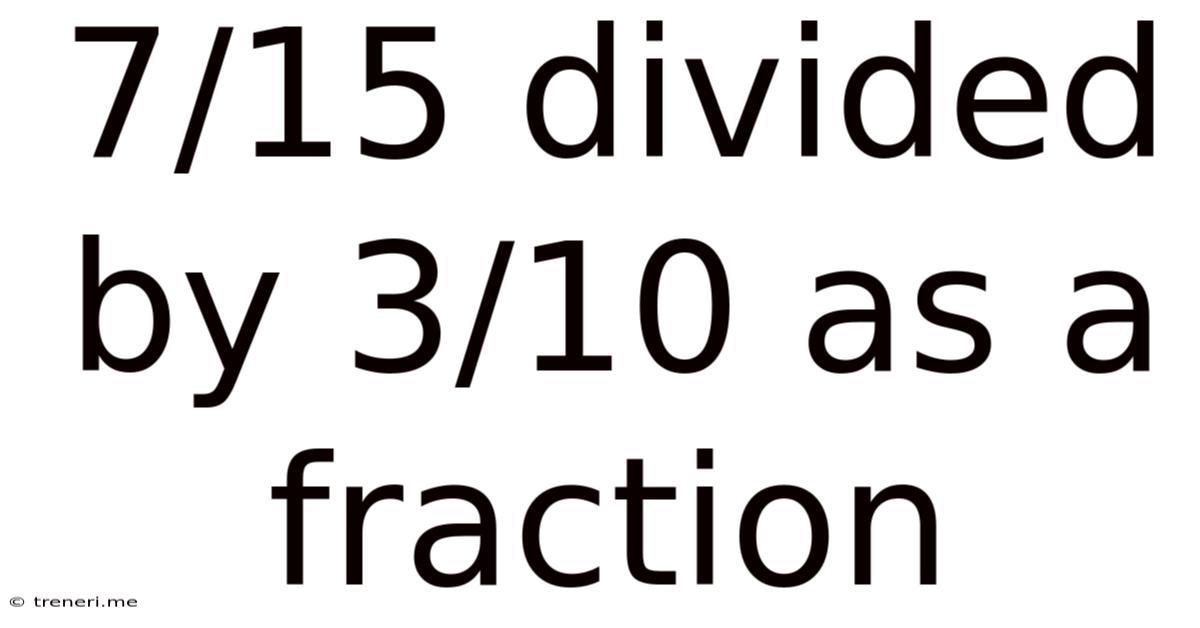7/15 Divided By 3/10 As A Fraction
Treneri
May 10, 2025 · 4 min read

Table of Contents
7/15 Divided by 3/10 as a Fraction: A Comprehensive Guide
Dividing fractions can seem daunting, but with a clear understanding of the process, it becomes straightforward. This comprehensive guide will walk you through dividing 7/15 by 3/10, explaining the steps, the underlying principles, and offering additional examples to solidify your understanding. We'll also delve into the practical applications of fraction division and explore related concepts to enhance your mathematical skills.
Understanding Fraction Division
Before tackling the specific problem of 7/15 divided by 3/10, let's refresh our understanding of fraction division. The core principle revolves around reciprocals and multiplication.
When we divide by a fraction, we essentially multiply by its reciprocal. The reciprocal of a fraction is simply the fraction flipped upside down. For instance, the reciprocal of 3/10 is 10/3.
Therefore, dividing 7/15 by 3/10 is equivalent to multiplying 7/15 by 10/3. This is represented mathematically as:
(7/15) ÷ (3/10) = (7/15) x (10/3)
Step-by-Step Solution: 7/15 Divided by 3/10
Now, let's solve the problem step-by-step:
-
Find the reciprocal of the second fraction: The reciprocal of 3/10 is 10/3.
-
Rewrite the division as multiplication: (7/15) ÷ (3/10) becomes (7/15) x (10/3).
-
Multiply the numerators (top numbers): 7 x 10 = 70
-
Multiply the denominators (bottom numbers): 15 x 3 = 45
-
Simplify the resulting fraction: We now have the fraction 70/45. To simplify, we find the greatest common divisor (GCD) of 70 and 45. The GCD of 70 and 45 is 5.
-
Divide both the numerator and the denominator by the GCD: 70 ÷ 5 = 14 and 45 ÷ 5 = 9.
-
Final Answer: The simplified fraction is 14/9. This can also be expressed as a mixed number: 1 and 5/9.
Visualizing Fraction Division
Visualizing fraction division can help solidify understanding. Imagine you have 7/15 of a pizza, and you want to divide it into portions that are each 3/10 of a pizza. How many portions can you get? The answer, as we've calculated, is 14/9 portions. This means you can get slightly more than one full portion (1 and 5/9 portions) of the size 3/10 from your 7/15 pizza.
Practical Applications of Fraction Division
Fraction division has numerous practical applications in various fields:
-
Cooking and Baking: Scaling recipes up or down requires dividing fractions. If a recipe calls for 1/2 cup of flour and you want to make half the recipe, you'll need to divide 1/2 by 2.
-
Sewing and Tailoring: Calculating fabric requirements involves dividing fractions. If you need 2/3 yards of fabric for one garment and you want to make three garments, you'll need to multiply 2/3 by 3. This demonstrates a direct application of fraction multiplication which is the core of fraction division.
-
Construction and Engineering: Precise measurements are crucial, and fraction division is often necessary for accurate calculations.
-
Finance and Budgeting: Dividing budgets into fractions for different expenses is a common application.
Expanding Your Understanding: Related Concepts
To further enhance your understanding, let's explore related mathematical concepts:
Mixed Numbers and Improper Fractions:
In our solution, we arrived at an improper fraction (14/9), where the numerator is larger than the denominator. This can be easily converted into a mixed number (1 and 5/9) by dividing the numerator by the denominator. Understanding this conversion is crucial for practical applications.
Greatest Common Divisor (GCD):
Finding the GCD is essential for simplifying fractions to their lowest terms. Several methods exist for finding the GCD, including the Euclidean algorithm. The ability to find the GCD efficiently is vital for working with fractions effectively.
Least Common Multiple (LCM):
While not directly used in this specific problem, the LCM is important when adding or subtracting fractions. The LCM of two numbers is the smallest number that is a multiple of both.
Complex Fractions:
A complex fraction has a fraction in either the numerator, the denominator, or both. Solving complex fractions involves simplifying the fractions within the larger fraction before performing the division or multiplication.
Further Practice Problems
To solidify your understanding of fraction division, try these practice problems:
- 5/8 ÷ 1/4
- 2/3 ÷ 5/6
- 1/2 ÷ 3/4
- 9/10 ÷ 3/5
- 15/20 ÷ 5/8
Remember to follow the same steps as outlined above: find the reciprocal, rewrite as multiplication, multiply numerators and denominators, and simplify the resulting fraction.
Conclusion
Dividing fractions, although initially appearing complex, becomes manageable with practice and a solid understanding of the underlying principles. By mastering the process of finding reciprocals and applying the rules of multiplication, you can confidently tackle any fraction division problem. Remember to always simplify your answer to its lowest terms. This guide provides a strong foundation for further exploration of fraction-related concepts and their numerous practical applications in various fields. Consistent practice is key to solidifying these skills and developing mathematical fluency.
Latest Posts
Latest Posts
-
Size 8 Ring Size In Cm
May 10, 2025
-
Greatest Common Factor Of 12 And 42
May 10, 2025
-
2 3 Cup Of Milk In Ml
May 10, 2025
-
12 Out Of 20 Letter Grade
May 10, 2025
-
Cuantos Dias Trae Este Mes De Enero
May 10, 2025
Related Post
Thank you for visiting our website which covers about 7/15 Divided By 3/10 As A Fraction . We hope the information provided has been useful to you. Feel free to contact us if you have any questions or need further assistance. See you next time and don't miss to bookmark.